James
Clerk Maxwell (Mathematician & Physicist) 1831-1879
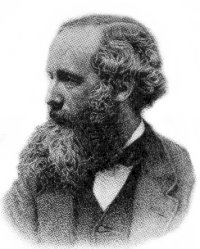
 James
Clerk Maxwell was born on the 13th June, 1831, in Edinburgh, Scotland.
He was the only child of John Clerk Maxwell of Middlebie and his wife Frances
Cay. When he was two the family moved to their country home of Glenlair in Kirkcudbrightshire.
James
Clerk Maxwell was born on the 13th June, 1831, in Edinburgh, Scotland.
He was the only child of John Clerk Maxwell of Middlebie and his wife Frances
Cay. When he was two the family moved to their country home of Glenlair in Kirkcudbrightshire.
James
was private educated for a while, and it was claimed by his tutor that he was a
slow learner. Though as a young child he was very curious and a story that his
mother recalled was of his persistent interest in the doorbell wire and where it
led. He also possessed a fantastic memory. In 1841 he started school at the
Edinburgh Academy, where fellow pupils nicknamed him 'daftie.' At the age of 15
he sent his first paper to the Royal Society in Edinburgh. The paper on The
Description of Oval Curves described curves which could be constructed with
drawing pins and thread in a similar manner to that of ellipses.
James
continued his education on entering the University of Edinburgh at the age of
16. During his time there he published a further two papers, finally leaving
Edinburgh in 1850 for Cambridge University first at Peterhouse, soon transfering
to Trinity College where his remarkable talents
were recognized. He graduated in 1854 as second wrangler and won the Smith's
prize for an essay containing original research. James was then elected a fellow
of Trinity College in 1855, then in 1856 he accepted a post as professor of
natural philosophy at the Marischal College in Aberdeen and in the same year he
started work on his work in electricity and magnetism.
James wrote an paper in 1857 demonstrating theoretically that the rings of
Saturn must consist of many fragments of matter rather than being solid, a fact
which was confirmed by the Voyager Probes over 100 years later.
James
was married on 2nd June 1858 to Katherine Mary, daughter of the very Rev. Danial
Dewar, Principal of Marischal College and University, Aberdeen. Two years later
in 1860 he moved to London, taking up post as professor of natural philosophy at
Kings College London, after being made redundant due to the merger of the two
Aberdeen Universities. In the same year he submitted papers to the Royal Society
on colour and colour blindness, and demonstrated in a lecture that it was
possible to produce colour photographs. Then in 1865 he resigned his post as
professor at Kings college returning home to Glenair, though he frequently
visited London and maintained his position as an external examiner for the
Mathematical (Tripos) exams at Cambridge.
James
Clerk Maxwell continued his work on electricity and magnetism and around 1865
arrived at his electromagnetic theory of light. He viewed light as consisting of
transverse waves of electric and magnetic force and had come to this conclusion
by his explanation of Michael Faradays discovery of electromagnetic induction in
mathematical terms. He had constructed a model and found that "displacement
currents" were produced in dielectric material as a result of the
induction. James then went on to discover that these displacement currents could
be the basis for transverse waves. He calculated that the velocity of these
waves to be that of the speed of light. Realising that there was no set limit on
the wave length of these waves, he predicted the existence of other
electromagnetic waves. His theory also suggested the ability to create
electromagnetic waves artificially. Maxwell's theory was generally disregarded
until Heinrich Hertz's discovery of radio waves in 1887. Finally in 1873 he
published his Treatise on Electricity and Magnetism which contains his famous
Maxwell equations.
He
also made contributions to physics most notably in his application of
statistical probabilities of gases, producing the law of statistical
distribution of the mean velocities of molecules in a gas. This included the
calculation of their mean-free path and of the co-efficient of friction for
gases. His ideas have also stimulated or helped research in other disciplines
including Maxwell's demon in information technology and in Johannes Diederik van
der Waals' theory of fluids.
In
1871 James took the new position of Cavendish professor of experimental physics
at Cambridge, where he headed, and supervised during construction of, the new
Cavendish laboratories. He later founded a scholarship in physics at Cambridge.
James Clerk Maxwell died on the 5th November, 1879 aged just
48 and was buried in the small churchyard at Parton in the Stewartry of
Kirkcudbright.
(Now
we are in the atomic and space age. Changes have occurred in our knowledge of
the the universe, and our way of life that few in the nineteenth century dreamed
of. And as the general public looks back to see who led the way they justifiably
refer to Albert Einstein, but he in turn said that it was James Clerk Maxwell
who was the pathfinder. In our twentieth century those who understand consider
him among the greatest scientists of all time, and could be the greatest son
that Scotland ever produced.) Rev.
Andrew C. MacKay Minister of Corsock 1979.
Jonathan
Dixon Maxwell (Pioneer Motor Car Maker) 1864-1928
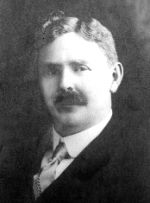
 Jonathan
Dixon Maxwell was born in Howard County Indiana in 1864 the son of Joseph and
Nancy Maxwell. He was trained as a machinist in the railroad industry but was
operating a bicycle repair shop with Elnier Apperson when he assisted him in
building Elwood Haynes's first car in 1893 (now in the Smithsonian Institute).
This partnership became the Northern Motor Car Company. Jonathan had also worked
with Eli Olds in developing the Reo, later renamed, the Oldsmobile.
Jonathan
Dixon Maxwell was born in Howard County Indiana in 1864 the son of Joseph and
Nancy Maxwell. He was trained as a machinist in the railroad industry but was
operating a bicycle repair shop with Elnier Apperson when he assisted him in
building Elwood Haynes's first car in 1893 (now in the Smithsonian Institute).
This partnership became the Northern Motor Car Company. Jonathan had also worked
with Eli Olds in developing the Reo, later renamed, the Oldsmobile.
In 1903 he
left the Northern Motor Car Company and joined with Benjamin Briscoe in founding
the Maxwell-Briscoe Motor Company. Jonathan designed the first Maxwell car and
using an existing plant at Tarrytown, New York, they started production on June
1904, building 532 Maxwell cars in the first year Their low priced, two cylinder
runabouts were the first in America to have metal bodies and amongst the first
to have shaft drive rather than the chain and sprocket drive derived from the
bicycle. During his working career, Jonathan was to hold no less than 19 automotive
patents. In 1907, a new plant was built at Newcastle Indiana, which is still
part of Chrysler facilities in that city. By 1908, the Maxwell-Briscoe Motor
Company was one of the four biggest auto-making companies in America along with
Ford, Buick, Reo (Oldsmobile).
Manufacture
of the two cylinder runabouts and larger four-cylinder cars continued until
1912 when their new, short-lived United States Motor Company, formed to rival
General Motors Corporation, failed. Jonathan then split from Briscoe and went
on to form the Maxwell Motor Corporation, financed by Walter Flanders, to build
Maxwell cars. The Maxwell production plants included factories at Newcastle
Indiana, Tarrytown New York, Pawtucket Rhode Island, Dayton and Highland Park
in Detroit as well as facilities in Canada. The Maxwell Motor Company also leased
the Chalmers Motor Company plant to augment their Highland Park facilities,
both of which were needed by Maxwell to fill World War I government orders.
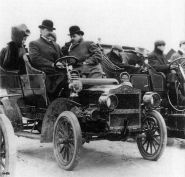 |
|
JDM
at the wheel of a
1907
Maxwell
|
By 1920 the
Maxwell Motor Company, Inc., owed some $43,000,000 and was on the verge of bankruptcy.
Walter P. Chrysler, who had retired as President of Buick and vice-president
of General Motors, was asked to head-up a reorganisation committee, which arranged
for the purchase of the combined assets of Maxwell and Chalmers and formed Maxwell
Motor Corporation in May 1921. Chrysler became Chairman of the Board. The company
continued to build the Chalmers car and an improved Maxwell car, advertised
as the "Good Maxwell." In 1924 the Chalmers marque became Chrysler with the
introduction of a totally new car, the Chrysler Six which was designed by three
new engineers, Carl Breer, Owen Skelton, and Fred Zeder. The following year
Chrysler changed the company name to the Chrysler Corporation and the Maxwell
car became the Chrysler Four, the core of its engineering being used as a platform
for the new Chrysler Plymouth of 1928.
Anne
Caroline Maxwell (Nursing Pioneer) 1851-1929

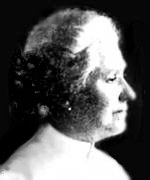 One
of America's early nurse leaders, Anna Caroline Maxwell validated the effectiveness
of appropriately trained nurses during the Spanish-American War and thus influenced
establishment of the Army Nurse Corps in 1901. From 1892 to 1921, Maxwell served
as the first superintendent of nurses at the Presbyterian Hospital Training
School for Nurses in New York City where she devoted her career to elevating
educational standards for nursing.
One
of America's early nurse leaders, Anna Caroline Maxwell validated the effectiveness
of appropriately trained nurses during the Spanish-American War and thus influenced
establishment of the Army Nurse Corps in 1901. From 1892 to 1921, Maxwell served
as the first superintendent of nurses at the Presbyterian Hospital Training
School for Nurses in New York City where she devoted her career to elevating
educational standards for nursing.
Born in Bristol, New York, on March 14, 1851, Maxwell moved to Canada with her
parents during the early years of her childhood. Returning to the United States
in 1874, she settled in Boston and entered the Boston City Hospital Training
School for Nurses in 1878. Maxwell studied nursing under the supervision of
Linda Richards and completed the requirements for a diploma in 1880. Following
employment as superintendent of nurses in Montreal, Boston, and New York, Maxwell
accepted the challenge of organizing the new training school for nurses at Presbyterian
Hospital in New York City. Beginning with a two-year course of classroom instruction
and clinical practice in medical/surgical nursing and obstetrics, Maxwell soon
added contagious disease nursing to the curriculum. By the turn of the century,
the course of study was expanded to three years and by 1917, affiliation with
Teachers College provided the impetus for establishment of a five-year program
leading to a bachelor of science degree from Columbia University and a nursing
diploma from Presbyterian Hospital.
An expert organizer and administrator, Maxwell was a charter member of the American
Society of Superintendents of Training Schools for Nurses (1893), forerunner
of the National League for Nursing, and the Nurses' Associated Alumnae of the
United States and Canada (1897), forerunner of the American Nurses Association.
She was also a charter member of the International Council of Nurses (1899)
and the American Red Cross Nursing Service (1899), and participated in founding
the American Journal of Nursing and the Isabel Hampton Robb Scholarship Fund.
During the Spanish-American War, Maxwell petitioned the surgeon general for
permission to bring trained women nurses to military hospitals to care for the
sick and wounded. Sent to a field hospital in Chicamauga, Georgia, Maxwell and
her nurses found inadequate sanitation, rampant disease, and a high death rate.
With skill and determination, they restored order, improved conditions, and
reversed an appalling situation.
During World War I, Maxwell again played a central role in preparing nurses
for active military service. Following the war, she worked to achieve military
rank for nurses in the armed forces. Recognized by colleagues as one of nursing's
pioneers, Maxwell was dedicated to improved nursing education, standardizing
nursing procedures, and increasing public acceptance of nursing as a profession.
She was the recipient of a medal from the French government for her contributions
to nursing throughout the world, and was buried will full military honors in
Arlington National Cemetery upon her death in 1929. In 1996 her name and memory
was induced into the Nursing Hall of Fame.
(Text
and Photograph; Nursing Hall of Fame)
Lucien Bonaparte Maxwell
(Frontiersman, Land Owner) 1818-1875
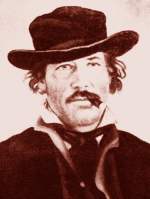
 Lucien
Bonaparte Maxwell was born in Kaskaskia, Illinois, on 14th September 1818. He
was the son of a Scots-Irish merchant named Hugh H. Maxwell and his French Canadian
wife Marie Odilie Menard. Lucian's unusual first names were a clear indications
of his father's anti-British feelings. The family had become prosperous fur-trading
with the frontiersmen who came into town and Lucien enjoyed a good education.
When his father died in 1834, Lucian left school and took to the mountains learning
the life of a trapper and frontiersman from his father's former business contacts.
During this time he befriended Kit Carson and they travelled together off and
on for the next ten years. Lucien arrive in Taos, New Mexico, in 1838 and established
his trading base there. He is reputed to have spoken several languages including
French, Spanish and the rudiments of a number of native Indian tongues. He was
a popular young man and worked hard. He was hired as a hunter by John Fremont
in 1842 and accompanied him on his mapping expeditions along with Kit Carson.
Lucien
Bonaparte Maxwell was born in Kaskaskia, Illinois, on 14th September 1818. He
was the son of a Scots-Irish merchant named Hugh H. Maxwell and his French Canadian
wife Marie Odilie Menard. Lucian's unusual first names were a clear indications
of his father's anti-British feelings. The family had become prosperous fur-trading
with the frontiersmen who came into town and Lucien enjoyed a good education.
When his father died in 1834, Lucian left school and took to the mountains learning
the life of a trapper and frontiersman from his father's former business contacts.
During this time he befriended Kit Carson and they travelled together off and
on for the next ten years. Lucien arrive in Taos, New Mexico, in 1838 and established
his trading base there. He is reputed to have spoken several languages including
French, Spanish and the rudiments of a number of native Indian tongues. He was
a popular young man and worked hard. He was hired as a hunter by John Fremont
in 1842 and accompanied him on his mapping expeditions along with Kit Carson.
Returning to Taos in mid 1844, Lucian married, thirteen year old, Maria de la
Luz, the only daughter of Charles Beaubien. Beaubien, a French-Canadian citizen
of Mexico, was Taos' most prominent resident. A year earlier, with three partners
and some underhand dealings, he had got a large Land Grant along the foothills
of the Sangre de Cristo Mountains neighbouring the Santa Fe Trail. Maxwell returned
to the trail immediately after his marriage, working again with Fremont for
a couple of years before setting up a ranch in the Cimarron area near his father-in-law.
Early in 1847, Mexicans and Pueblo Indians rebelled and caused a terrible massacre
in Taos in which Beaubien's son, Narciso, and his one of his partners were killed.
In 1847 Maria (or Luz as she was known) gave birth to Lucian only son Peter.
Lucian and Luz also had five daughters; Virginia, Sophia, Paulita, Emilia and
Odile. Lucian's business practices began to make him quite wealthy, but he did
not stop travelling the wild country and it often brought him into contact with
Indian war parties. In 1848, he and his party were ambushed by Jicarilla Apaches
and all save one, all were either injured or killed, Lucian escaped back to
Taos were he spent the rest of the year recovering. He was now running much
of Beaubien's Land Grant, as well as a trading business at Cimarron where he
was the post master and the Indian agent.
In 1864, Charles Beaubien died and the great majority of the Land Grant passed
through his daughter to his son-in-law, Lucian Maxwell. Lucian was quick to
round up the other beneficiaries of Beaubien's will and buy up the remaining
portions of the Land Grant and so it was that with in two years, Lucian Maxwell,
was the largest private land owner in America with 2680 square miles or 1,714,765
acres at his command. At the same time prospectors, panning down the Moreno
Valley discovered gold. By the Spring, the rush was on and Maxwell was selling
leases by the handful. Settlers and miners were moving into the area in a flood
and Maxwell was making a fortune. Unfortunately his paperwork did not keep up
with the influx and in later years, lease owners were embroiled in much argument
of ownership. These arguments were often played out in true western style with
guns and bloodshed. The period became known as the Colfax County War. The Maxwells
now had a big house in Cimarron which welcomed hundreds of freeloading guests
each year. The house was chock-full of young Navajo servants and over the Land
Grant, Maxwell had over 500 employees. Nearly all Maxwell's business was done
on a handshake, he never checked the bagsful of money that were handed over
to him but was scrupulous with all his gambling debts.
The responsibility
of running such a huge concern wearied Lucian and by 1869 he had had enough
of the fighting leaseholders and dissolute, displace Indians that were camped
on his doorstep and he sort to sell the land. In January 1870 buyers from England
were found and a deal put together in which Maxwell received $2,010,000 for
the Land Grant. He bought the old union army camp Fort Sumner some two hundred
miles to the south. There, he rebuilt the old officers quarters into a huge
house and moved his massive household down to his new home. Later that year,
he founded the First National Bank in Santa Fe, but tired of it and sold it
on quickly. He then invested in the Texas-Pacific Railroad, but lost a considerable
sum in it's construction. He lived out his last days surrounded by his entourage
of camp followers and freeloaders, gambling away his time in the converted fort.
On 25th June 1875, Lucian died and was buried at Fort Sumner. He was succeeded
by his son Peter and his wife, Luz, who lived on until 1900. Maxwell was an
honest trader whose handshake connected the three cultures that met across his
land. He was an admirable risk taker who sought greater rewards than chunks
of gold. He was hospitable, generous
and upright, and dispensed his large wealth acquired by industry and genius
with an open hand to both stranger and the needy.
A
complete history of the Maxwell Land Grant and the Maxwell family called "Tassie
Maxwell and the Maxwell Land Grant Family" by Louis Serna can be obtained
from Sernabook@aol.com


 James
Clerk Maxwell was born on the 13th June, 1831, in Edinburgh, Scotland.
He was the only child of John Clerk Maxwell of Middlebie and his wife Frances
Cay. When he was two the family moved to their country home of Glenlair in Kirkcudbrightshire.
James
Clerk Maxwell was born on the 13th June, 1831, in Edinburgh, Scotland.
He was the only child of John Clerk Maxwell of Middlebie and his wife Frances
Cay. When he was two the family moved to their country home of Glenlair in Kirkcudbrightshire.

 Jonathan
Dixon Maxwell was born in Howard County Indiana in 1864 the son of Joseph and
Nancy Maxwell. He was trained as a machinist in the railroad industry but was
operating a bicycle repair shop with Elnier Apperson when he assisted him in
building Elwood Haynes's first car in 1893 (now in the Smithsonian Institute).
This partnership became the Northern Motor Car Company. Jonathan had also worked
with Eli Olds in developing the Reo, later renamed, the Oldsmobile.
Jonathan
Dixon Maxwell was born in Howard County Indiana in 1864 the son of Joseph and
Nancy Maxwell. He was trained as a machinist in the railroad industry but was
operating a bicycle repair shop with Elnier Apperson when he assisted him in
building Elwood Haynes's first car in 1893 (now in the Smithsonian Institute).
This partnership became the Northern Motor Car Company. Jonathan had also worked
with Eli Olds in developing the Reo, later renamed, the Oldsmobile.
 One
of America's early nurse leaders, Anna Caroline Maxwell validated the effectiveness
of appropriately trained nurses during the Spanish-American War and thus influenced
establishment of the Army Nurse Corps in 1901. From 1892 to 1921, Maxwell served
as the first superintendent of nurses at the Presbyterian Hospital Training
School for Nurses in New York City where she devoted her career to elevating
educational standards for nursing.
One
of America's early nurse leaders, Anna Caroline Maxwell validated the effectiveness
of appropriately trained nurses during the Spanish-American War and thus influenced
establishment of the Army Nurse Corps in 1901. From 1892 to 1921, Maxwell served
as the first superintendent of nurses at the Presbyterian Hospital Training
School for Nurses in New York City where she devoted her career to elevating
educational standards for nursing.